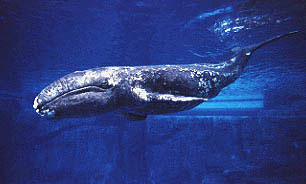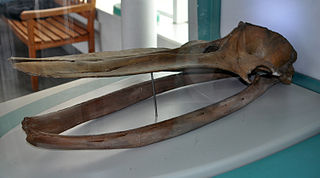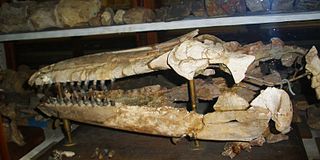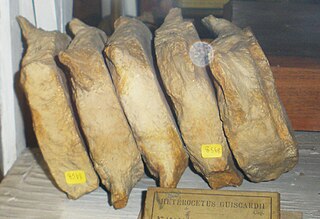
Eschrichtiidae or the gray whales is a family of baleen whale with a single extant species, the gray whale, as well as three described fossil genera: Archaeschrichtius and Eschrichtioides from the Miocene and Pliocene of Italy respectively, and Gricetoides from the Pliocene of North Carolina. More recent phylogenetic studies have found this family to be invalid, with its members nesting inside the Balaenopteridae. The names of the extant genus and the family honours Danish zoologist Daniel Eschricht.

Megalodon, meaning "big tooth", is an extinct species of mackerel shark that lived approximately 23 to 3.6 million years ago (Mya), during the Early Miocene to the Pliocene. It was formerly thought to be a member of the family Lamnidae and a close relative of the great white shark. However, it is now classified into the extinct family Otodontidae, which diverged from the great white shark during the Early Cretaceous. Its genus placement is still debated, authors placing it in either Carcharocles, Megaselachus, Otodus, or Procarcharodon. This is because transitional fossils have been found showing that megalodon is the final chronospecies of a lineage of giant sharks originally of the genus Otodus which evolved during the Paleocene.

Cetotherium is an extinct genus of baleen whales from the family Cetotheriidae.

Zygophyseter varolai is an extinct sperm whale that lived during the Tortonian age of the Late Miocene 11.2 to 7.6 million years ago. It is known from a single specimen from the Pietra Leccese Formation in Italy. It was a member of a stem group of fossil macroraptorial sperm whales also including Brygmophyseter, Acrophyseter, and Livyatan. It probably grew to be around 6.5 to 7 meters in length and shared some characteristics with other raptorials, such as large teeth with tooth enamel that were functional in both the upper and lower jaws which the modern sperm whale lacks. It also had a beak, the ability to echolocate prey, and could have probably swum faster than the modern-day sperm whale which goes 4 kilometers per hour (2.5 mph). These were probably used in the capture of large prey, such as large fish, seals, and whales. In fact, its common name, the killer sperm whale, refers to its feeding habits that would have had a resemblance to the modern-day killer whale.

Brygmophyseter, known as the biting sperm whale, is an extinct genus of toothed whale in the sperm whale family with one species, B. shigensis. When it was first described in 1994, the species was placed in the genus Scaldicetus based on tooth morphology, but this was later revised in 1995. In 2006, it was classified into the genus Naganocetus, which is considered to be a junior synonym. The only known specimen, a nearly complete skeleton, was dated to be around 14–15 million years old. Brygmophyseter is thought to have been 7 meters (23 ft) long, and it probably had 11 or 12 teeth in the upper and lower jaws. Brygmophyseter is part of a group of macroraptorial sperm whales which tended to be apex predators using their large teeth to catch struggling prey such as whales. It had a spermaceti organ which was probably used for biosonar like in the modern sperm whale. The whale has made an appearance on The History Channel's TV series Jurassic Fight Club.

Australodelphis mirus is an extinct Pliocene dolphin. A. mirus is known from fossils found in the Sørsdal Formation, Mule Peninsula, Vestfold Hills, East Antarctica. The genus has been described as an example of convergent evolution with beaked whales.

Livyatan is an extinct genus of macroraptorial sperm whale containing one known species: L. melvillei. The genus name was inspired by the biblical sea monster Leviathan, and the species name by Herman Melville, the author of the famous novel Moby Dick about a white bull sperm whale. It is mainly known from the Pisco Formation of Peru during the Tortonian stage of the Miocene epoch, about 9.9–8.9 million years ago (mya); however, finds of isolated teeth from other locations such as Chile, Argentina, South Africa, and Australia imply that either it or a close relative survived into the Pliocene, around 5 mya, and was present throughout the Southern Hemisphere. It was a member of a group of macroraptorial sperm whales and was probably an apex predator, preying on whales, seals, and so forth. Characteristically of raptorial sperm whales, Livyatan had functional, enamel-coated teeth on the upper and lower jaws, as well as several features suitable for hunting large prey.

Orcinus citoniensis is an extinct species of killer whale identified in the Late Pliocene of Italy and the Early Pleistocene of England. It was smaller than the modern killer whale, 4 m (13 ft) versus 7 to 10 m, and had around 8 more teeth in its jaw. It may have resembled the modern killer whale in appearance, and could represent a transitional species between the modern killer whale and other dolphins. O. citoniensis may have hunted large fish and squid in pods, and coexisted with other large predators of the time such as the orcinine Hemisyntrachelus and the extinct shark Otodus megalodon.

Piscobalaena is an extinct genus of cetaceans, which lived from the Middle to Late Miocene epochs in Peru and Florida. Its fossils have been found in the Pisco Formation of Peru and the Bone Valley Formation of Florida. At least some individuals of this diminutive whale were preyed on by the shark C. megalodon.

Hemisyntrachelus is an extinct genus of cetacean.

Heterocetus is a dubious genus of extinct cetacean.

Titanocetus is a genus of extinct cetaceans closely related to the family Cetotheriidae.

Eschrichtioides is an extinct genus of baleen whale known from the early Pliocene of northern Italy. Its type species, E. gastaldii, had a complex taxonomic history, starting as a cetothere, then as an extinct member of Balaenoptera, before being finally recognized as a relative of the gray whale.

Cetotheriopsis is a genus of extinct cetaceans of the family Cetotheriopsidae.

Pliophoca is an extinct genus of seal in the family Phocidae.

Albicetus is a genus of stem-sperm whales that lived during the Miocene Epoch, around 15 million years ago, and was discovered in Santa Barbara, California in 1909. It was categorized for decades as belonging to a group of extinct walruses erroneously thought to be sperm whales. It was named Albicetus, meaning "white whale", is a reference to the leviathan in Herman Melville's classic 1851 novel Moby-Dick.

Kogia pusilla is an extinct species of sperm whale from the Middle Pliocene of Italy related to the modern day dwarf sperm whale and pygmy sperm whale. It is known from a single skull discovered in 1877, and was considered a species of beaked whale until 1997. The skull shares many characteristics with other sperm whales, and is comparable in size to that of the dwarf sperm whale. Like the modern Kogia, it probably hunted squid in the twilight zone, and frequented continental slopes. The environment it inhabited was likely a calm, nearshore area with a combination sandy and hard-rock seafloor. K. pusilla likely died out due to the ice ages at the end of the Pliocene.
Hoplocetus is an extinct genus of raptorial cetacean of the sperm whale superfamily, Physeteroidea. Its remains have been found in the Miocene of Belgium, France, Germany and Malta, the Pliocene of Belgium and France, and the Pleistocene of the United Kingdom and South Carolina.
Miobalaenoptera is an extinct genus of rorqual from the Late Miocene (Messinian) of Japan.





















